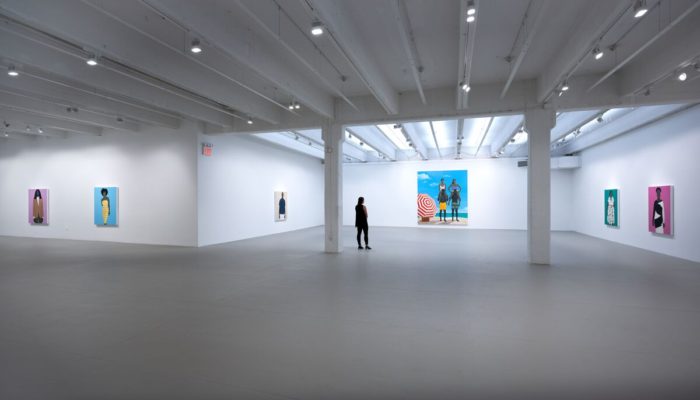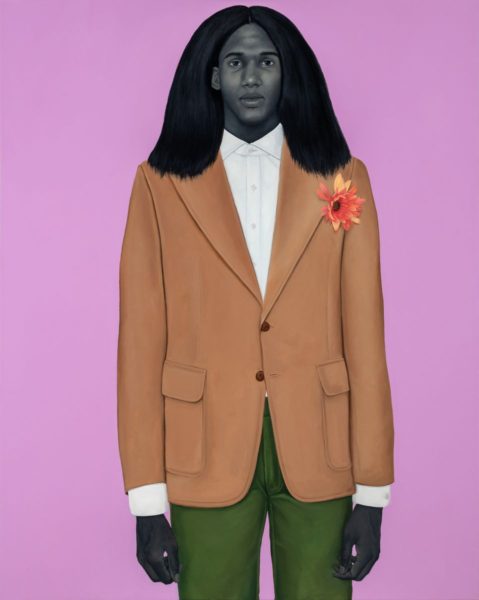
Amy Sherald, a Baltimore-based artist, is a leading exponent of an innovative realism dedicated to capturing the appearance of black people. Working with people she meets on the street, Sherlad takes snapshots of them, painting most of her subjects in second-hand clothing. Her working process is meticulous–Sherald does an involved charcoal drawing of the person, and only after that does she paint the figure. The faces of her subjects are done with grisaille. The results demonstrate close detail, recognition of the innate gravitas of the sitter, and an awareness that realistic portraiture has become an active artistic provenance for American people of African descent. While Sherald’s paintings do not purposely challenge art’s predilection for depicting the gentried and the prominent intelligentsia, it is clear that she is painting–with a leaning toward eminent presence–people who even a generation ago would not have received the attention they are currently being met with. This is a re-alignment of the casual preference for white culture in realist art, and it’s also an affirmation of the inherent grace and style of people of color who do not belong to the art world.

How does Sherald achieve her remarkably poised portraits in which social status is embraced without foreknowledge of class? By means of remarkable skill but, equally also, by means of an empathy that extends itself to her sitters’ aura, their attractive mixture of exquisite dress, cultural pride, and their awareness that they are participating in a world that they themselves are shaping. All the portraits have a photographic sense of detail, but they resonate in other ways as well–as indications of a gracefulness that for centuries was shut out of general culture. In the masterful oil portrait Sometimes the king is a woman (2019), a tall woman, wearing a white hair clasp that keeps her coiffeur high, presents herself to the public with yellow earrings and a white and black dress (the black stripes have rough edges, much like an abstract painting). Her gaze is direct, perhaps inquisitive; she meets her audience directly, with full confidence in her appearance. As happens with most of the works, the background is a single color–here it is pink. This woman is, for all purposes, queen of the moment and indefinitely.

Handsome (2019) is a young man who is exactly that: good-looking, quietly assured. He wears a dark-blue short-sleeve shirt with small white polka dots; his pants are white. His hair is short-cropped, his arms extend straight down to the side of his pants, and his gaze is serene–and alive. In general terms, the portrait is jaunty and informal, quietly cognizant of social status. Sherald renders a high society that does not have that much to do with established norms of success. This is a painting counter to unspoken assumptions about class and background, and it is essential in its presentation of people whose attractiveness might well go unnoticed, given society’s preference for the beauty of a dominant class. Sherald’s excellence as a painter shows us how current assumptions in the art world, regarding who gets seen and who gets shown need to be deeply challenged. Her sympathy with her setters is profoundly evident, being an extension of her innate rapport with the culture she belongs to. Maybe it is only now that such a rapport is gaining the recognition it deserves.

Another portrait of a handsome young black man has a long title: When I let go of what I am, I become what I might be (Self-imagined atlas) (2018). The name of the painting refers to what we must understand as the re-imagining of psychic historical burdens in favor of a new self–this is what Sherald does so very well. In this portrait, a tall, self-assured black man, with long hair flowing to the shoulders of his camel hair sports coat, wears green pants against a light mauve background while returning the gaze of the viewer. He sports a white shirt buttoned to the top and a red-orange carnation–presumably for some social event. This young man is quite young–likely in his late teens or early twenties–and his demeanor radiates the optimism and earnest hope we find in the youthful. Here Sherald is not only painting the present but also the future, in a work whose title underscores the open possibility of personal transformation. What comes through, in addition to the precision of her paintings’ details, is a determination to bring to the fore the personas of the people she paints, as well as a much-needed focus on people who are no longer socially invisible. Her point of view in these accomplished portraits is one of transcendent assertion, positing a time and a place and a people who are allowed to be as they are.
Amy Sherald: the heart of the matter…
Hauser & Wirth (22nd St)
10 Sep – 26 Oct 2019
